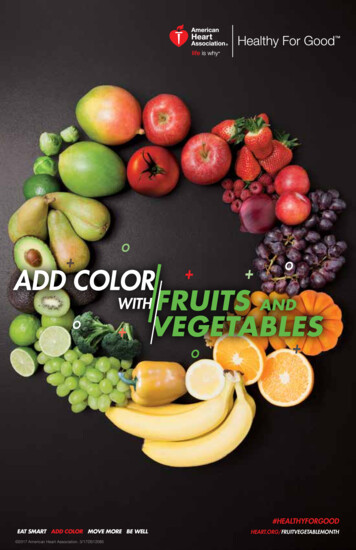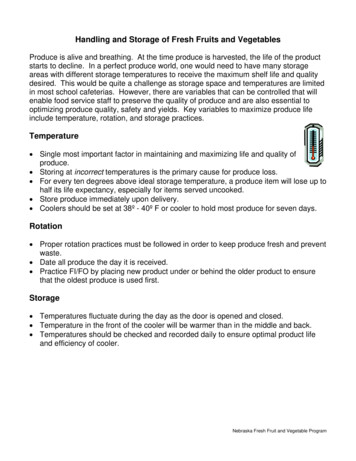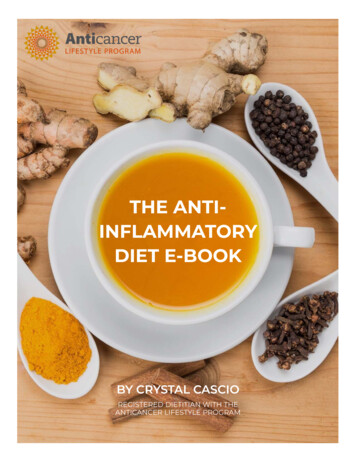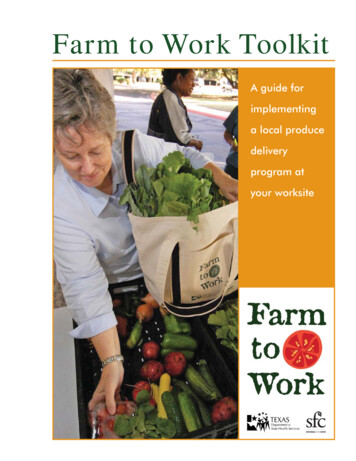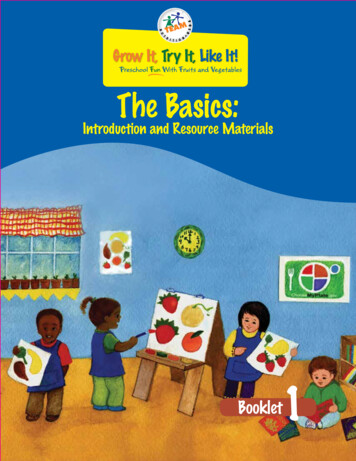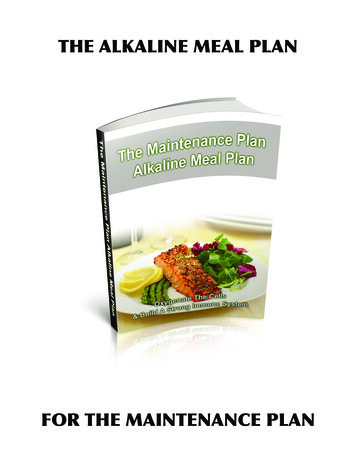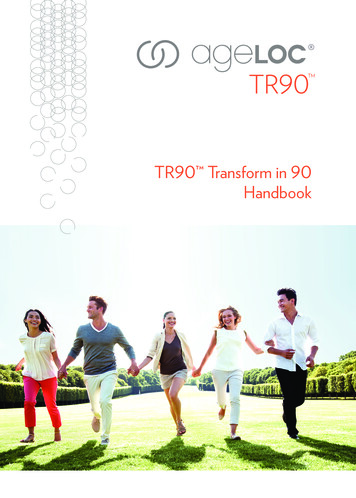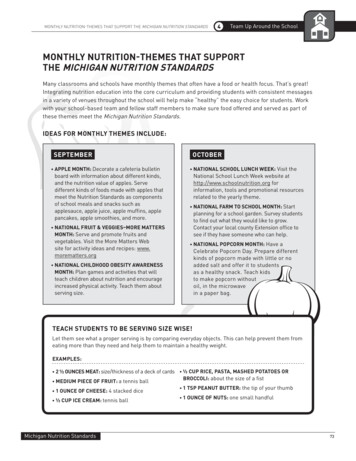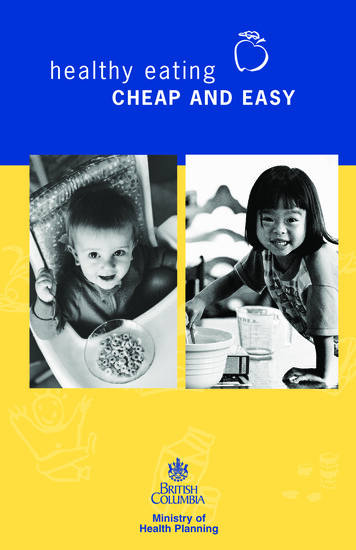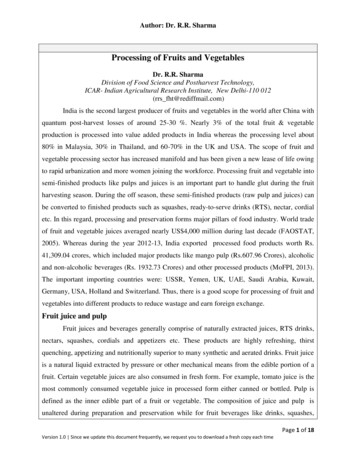
Transcription
Author: Dr. R.R. SharmaProcessing of Fruits and VegetablesDr. R.R. SharmaDivision of Food Science and Postharvest Technology,ICAR- Indian Agricultural Research Institute, New Delhi-110 012(rrs fht@rediffmail.com)India is the second largest producer of fruits and vegetables in the world after China withquantum post-harvest losses of around 25-30 %. Nearly 3% of the total fruit & vegetableproduction is processed into value added products in India whereas the processing level about80% in Malaysia, 30% in Thailand, and 60-70% in the UK and USA. The scope of fruit andvegetable processing sector has increased manifold and has been given a new lease of life owingto rapid urbanization and more women joining the workforce. Processing fruit and vegetable intosemi-finished products like pulps and juices is an important part to handle glut during the fruitharvesting season. During the off season, these semi-finished products (raw pulp and juices) canbe converted to finished products such as squashes, ready-to-serve drinks (RTS), nectar, cordialetc. In this regard, processing and preservation forms major pillars of food industry. World tradeof fruit and vegetable juices averaged nearly US 4,000 million during last decade (FAOSTAT,2005). Whereas during the year 2012-13, India exported processed food products worth Rs.41,309.04 crores, which included major products like mango pulp (Rs.607.96 Crores), alcoholicand non-alcoholic beverages (Rs. 1932.73 Crores) and other processed products (MoFPI, 2013).The important importing countries were: USSR, Yemen, UK, UAE, Saudi Arabia, Kuwait,Germany, USA, Holland and Switzerland. Thus, there is a good scope for processing of fruit andvegetables into different products to reduce wastage and earn foreign exchange.Fruit juice and pulpFruit juices and beverages generally comprise of naturally extracted juices, RTS drinks,nectars, squashes, cordials and appetizers etc. These products are highly refreshing, thirstquenching, appetizing and nutritionally superior to many synthetic and aerated drinks. Fruit juiceis a natural liquid extracted by pressure or other mechanical means from the edible portion of afruit. Certain vegetable juices are also consumed in fresh form. For example, tomato juice is themost commonly consumed vegetable juice in processed form either canned or bottled. Pulp isdefined as the inner edible part of a fruit or vegetable. The composition of juice and pulp isunaltered during preparation and preservation while for fruit beverages like drinks, squashes,Page 1 of 18Version 1.0 Since we update this document frequently, we request you to download a fresh copy each time
Author: Dr. R.R. Sharmacordial etc. the fruit juice or pulp, sugar, acid, colour, flavour etc., are mixed in appropriateproportions to a desirable taste.I.Fruit juice and beveragesA. Unfermented beveragesFruit juices which do not undergo alcoholic fermentation are termed as ‘unfermentedbeverages’. They include natural fruit juices, sweetened, RTS drinks, nectar, cordial, squash,crush, syrup, fruit juice concentrate and fruit juice powder. They are prepared by followingminimum standards as prescribed under Food Safety and Standards Regulation(FSSA), 2011(Table 1) and discussed as under:Table 1: Food Safety and Standards Regulation (FSSA) specifications for fruit beveragesMinimum % of totalsoluble solids in finalproduct (w/w)NaturalMinimum % offruit juice in finalproduct (w/w)100Maximum acidityexpressed ascitric acid (%)3.5Fruit xcluding orange andpineapple)Orange and ned juice1085-Lime/lemon Ready toserve beverageReady-to-servebeverage/drinkFruit juice --ProductUnsweetened juice*Preservative SO2/BA ppm specified by Food Safety and Standards Regulation, 2011,SO2- sulphur dioxide; BAbenzoic acidB. Fermented beveragesFermented fruit beverage is a fruit juice, which has undergone alcoholic fermentation byyeast (Saccharomyces cerevisae). The product contains varying amount of ethyl alcohol.Page 2 of 18Version 1.0 Since we update this document frequently, we request you to download a fresh copy each time
Author: Dr. R.R. SharmaApple cider, plum wine, grape wine, vermouth etc., are common fermented beverages.Method for preparation of fruit juice beverages (non-fermented beverages)1. Selection of fruits: All fruits are not suitable because of difficulties in extracting thejuice. The variety, maturity and locality of cultivation of the fruit influence the flavourand keeping quality of the juice. Only fully ripe fruits are selected as over ripe and unripefruits adversely affects the quality of the juice.2. Sorting and washing: Diseased, damaged or decayed fruits are rejected or trimmed off.Dirt and spray residues of arsenic, lead etc., are removed by washing with water or byusing dilute hydrochloric acid (0.5%) solution followed by washing in water.3. Juice extraction: Common equipment used for juice extraction of juice are fruit grater ormill, basket or hydraulic press, screw type juice extractor, rosing or burring machine,fruit pulper etc. There are two types of extraction methods i.e., single and doubleoperation system.a) Single operation: In single operation, screw type, plunger type or roller type press isgenerally used to crush and press the prepared fruit to extract the juice. Citrus fruitsegments are fed through a hopper, passed through conical screws and the juice flows outthrough the perforations while the pomace comes out at the end of the conical jacket. Thescrew type extractor is operated either manually or electricity. Removal of rind isrequired to avoid bitterness. Finally, the juice is strained through a thick cloth or a sieveto remove seeds.b) Double operation: In this system, the fruits are crushed and then pressed separately.Fruit like apple, aonla, berries, grapes, jamun, phalsa etc., are crushed in fruit grater orcrusher and the crushed mass is pressed by means of basket press and hydraulic press.Process variables for juice extraction for some fruits1. Soft fruits such as berries or tomatoes can be pressed through a fruit press or pulped byusing a juicer attachment to a food processor.2. Citrus fruits are usually reamed to extract the clear juice.3. Harder fruits like pineapple are peeled, pulped and pressed to extract the juice.4. Apple and pear fruits are crushed in a fruit grater and pressed in a hydraulic/basket pressto extract a clear juice.5. Passion fruit juice is prepared by using a pulper-finisher that separates peel and seedsPage 3 of 18Version 1.0 Since we update this document frequently, we request you to download a fresh copy each time
Author: Dr. R.R. Sharmafrom the pulp.The fruits like mango, guava, apricot, peach etc., from which the clear juice extraction isdifficult, are passed through the pulper to make pulp and then the pulp is utilized forpreparation of juice, fruit drinks and ready-to-serve beverages.4. Deaeration: Freshly extracted juice contains appreciable quantity of oxygen, which mayaffect the quality of juice. Most of the air is removed by subjecting the fresh juice to highvacuum. This process is called as deaeration and the equipment is known as thedeaerator. Heating of juice during heat processing also helps in removal of the air.5. Clarification of juice: Fruit and vegetable juices are clarified by using different methodslike straining or screening, settling or sedimentation and filtration.a) Straining or screening: Un clarified fruit juices contain varying amounts of suspendedmatter (broken fruit tissue, seed, skin, pectic substances, protein). Seeds and skin whichadversely affect the quality of juice are removed by straining through a muslin cloth orpower operated screening system or filter press.b) Finishing: Citrus juices need finishing for separating cloudy but otherwise clear juicefrom pulp, rag and seeds. The finisher separates the pulpy matter from the juice by theaction of a rotating auger inside a cylinder screen. Screen hole size range fromapproximately 0.020 to 0.030 inch in diameter, depending on the condition and softnessof the fruit. Finishing is judged by the pulp content in the orange fruit juice.c) Decantation: Decantation is the simplest method of clarification, in which the juicecontaining solids is allowed to settle down and then clear juice is decanted or siphonedoff. Keep juice at low temperature for long periods to facilitate clarification.d) Centrifugation: The clouding particles can be separated by centrifugal action. The juicecontaining solids is fed into a basket or disc type centrifuge, where the centrifugal forceseparates the light and dense components in each layer. The clear juice is collected andunwanted solids are separated.e) Enzymes: The plant carbohydrates, pectin, starch and proteins make the colloidalsuspension in the freshly extracted fruit juice. The pectinol enzyme is widely used forbetter juice recovery and clarification of fruit juices as it breaks pectin into soluble formthereby freeing the suspended particles which settle down and leaves the juice clear.Pectinol is more effective in the case of acidic juices. Fruit juices can be clarified in aboutPage 4 of 18Version 1.0 Since we update this document frequently, we request you to download a fresh copy each time
Author: Dr. R.R. Sharma1-2 hours at 40-50oC but requires 20 hours at 20oC. Similarly, proteolytic and starchliquefying enzymes such as amylases are used to remove protein and starch from fruitjuices.f) Physical finings: Certain fining agents, which have physical or mechanical action arekaolin, diatomaceous earth, Spanish clay, bentonite or china clay and are known as filteraids. Generally, 0.5 to 0.1 percent earth is mixed with fruit juice and then passed throughthe filter press.g) Chemical finings: Gelatin and casein are used to clarify the fruit juices and act partly toneutralize the electrical charged particles and partly by forming insoluble precipitate withthe constituents of the juice. The gelatin and casein combines with tannins and acid of thejuice. Depending on the tannin content of the fruit juice, gelatin solution is mixed andallowed to stand for 18 to 24 hours to ensure settling of precipitated matter. The clarifiedjuice is then siphoned off. Albumin (egg white) can also be used in clarification of juices.h) Clarification by freezing: Grape juice contains cream of tartar or potassium hydrogentartrate along with pulp and skin which is removed by freezing and thawing the juice orby refrigeration for a long period.i) Clarification by heating: During heating, the colloidal material in fruit juices coagulatesand settles down on cooling which can be separated by using a filter press. Forclarification of apple and pomegranate juice, the juice is heated to 80-850C for fewminutes and cooled immediately followed by filtration by passing the juice through afilter press.6. Addition of sugars: All juices are sweetened by adding sugar, except those of grapes andapple. Sugar can be added directly to the juice or as syrup made by dissolving it in water.Fruit squash, cordial, syrups are made by adding appropriate quantity of sugar into thepulp or juice using cane sugar.7. Preservation of juicesFruit juices, RTS and nectars are preserved by heat processing or by using class IIpreservatives like potassium meta-bisulphite (KMS) or sodium benzoate as describedhereunder:a) Pasteurization: It is a process in which juice is heated to 100oC or slightly below for asufficient time to inactivate/kill the micro-organisms causing spoilage. Usually juices arePage 5 of 18Version 1.0 Since we update this document frequently, we request you to download a fresh copy each time
Author: Dr. R.R. Sharmapasteurized between 75 and 880C for 30 sec to 30 min depending on the type of heatingsystem, nature of the juice and size of the container. Pasteurization can be performed atlow temperature for a long time (LTLT) or high temperature for short time (HTST).Commonly followed pasteurization methods are:i. Holding pasteurization: In this method, the prepared juice is filled into glass bottleswith a proper head space and the bottles are sealed airtight. After sealing the bottlesare pasteurized. However, this method is not followed for commercial scale products.ii. Pasteurization by overflow method:In this method, the juice is heated to atemperature about 2.5oC higher than the pasteurization temperature and filled into thehot sterilized bottles up to the brim. The sealed bottles are processed in boiling waterfor specified period and cooled.iii. Flash Pasteurization/HTST: In this process, the juice is heated only for short time ata temperature about 5.5oC higher than the pasteurization temperature, filled into thecontainers and sealed air tight under cover of a steam to sterilize the seal and thencooled. It can be used for processing of orange juice, apple and grape juice.b) Aseptic processing and packaging of fruit juices: Aseptic processing and packaging isdefined as the process in which a commercially sterile product is packed into presterilized container in a sterile environment. The system makes use of HTST sterilizationin the temperature range of 90-110oC for acid products (pH 4.6) and ultra-hightemperature (UHT) sterilization 121oC and above for low acid foods (pH 4.6). Productswith better nutritional value and excellent sensory quality are produced. Juices in tetrapack are processed commercially using aseptic processing, e.g., apple, litchi.c. Preservation with chemical: Benzoic acid (benzoates) and sulphur dioxide (Sulphites)are commonly used class II preservatives in juices. The limit of preservatives to beadded in various products as per FSSA is given in Table 2.i. Benzoic acid: Sodium salt of benzoic acid is generally used being soluble in water.Benzoic acid is more effective against yeast as compared to moulds. The quantity ofsodium benzoate required depends on the nature of the juice, its acidity and type ofmicrobial infection.ii. Sulphur dioxide: Potassium metabisulphite is commonly used as a source of sulphurdioxide. On reaction with the juice it forms sulphurous acid. SO2 is more effectivePage 6 of 18Version 1.0 Since we update this document frequently, we request you to download a fresh copy each time
Author: Dr. R.R. Sharmaagainst moulds and bacteria than yeast and also inhibits enzymes. Its effectivenessdepends on the acidity, pH, temperature and other substances present in the juice. Thischemical should not be used in naturally colored juices due to its bleaching effect, itshould not be used in juices to be packed in tin containers causing pinholes.Table 2: Limits for permitted preservatives in fruit juice and beverages as per Fruit ProductsOrderFruit juice/beveragesPreservative1.Fruit pulp or juice for conversions into jamsand other productsa. CherriesSO2b. Strawberries & RaspberriesSO2c. Other fruitsSO22. Fruit juice concentrate3.Squashes, crushes, fruit syrup,cordials, fruit juice and barley water.4. Sweetened ready to serve BeveragesSO2sharbats,SO2OrBenzoic acidSO2orBenzoic acidPart per million (ppm)3,0002,0001,0001,50035060070120d) Freezing Preservation: The properly frozen juice retains its freshness, colour, taste andaroma for a long time. De-aerated juice is transferred into containers, which arehermetically sealed and frozen. The more rapidly a juice is frozen, the smaller the icecrystal formed and the less the amount of colloidal matter coagulates. When the juice isfrozen to -18oC, practically all of the juice will be solid except for a little thick syrup inthe center of the containers. This method is good for heat sensitive juices.e) Preservation by drying: Micro-organisms need water for their growth and multiplicationand as the water is removed, they are unable to grow. Fruit juices can be preserved in theform of powder by different methods viz., spray drying, drum drying, freeze-drying,foam-mat drying etc. Fruit juice powders are highly hygroscopic and packed in hermeticsealed containers with in-package desiccant to prolong the shelf-life of the product.f) Preservation by carbonation: Carbonation is a process of mixing carbon dioxide underpressure with water, juice or beverages so that the product when served, gives off gas infine bubbles with a characteristics taste. In carbonated beverages, carbon dioxide contentPage 7 of 18Version 1.0 Since we update this document frequently, we request you to download a fresh copy each time
Author: Dr. R.R. Sharmaranging from 1 to 8 g/L. Though this concentration is much lower than that required (14.6g/L) for complete inhibition of microbial growth, yet it is significant in supplementing thelethal effect of acidity on pathogenic bacteria. Carbonation also helps in creatinganaerobic conditions unsuitable for yeasts and moulds and also reduces the oxidation ofascorbic acid. The keeping quality is enhanced by adding 50ppm sodium benzoate.g) Preservation by filtration: In this method, the clarified fruit juices (particularly appleand grapes) are passed through special filters, which are capable of retaining yeasts andbacteria. Various types of germ proof filters are used for this purpose and the method isused for soft drinks, fruit juices and wines.8. Filling and Processing: Bottles are thoroughly washed with hot water and filled leaving1.5-2.5 cm headspace. The bottles meant for heat processing are sealed by using crowncorks while those preserved by using class II preservatives can be sealed by using PP(pilfer proof) caps.II.Method of preparation of PulpThe fruit is washed thoroughly to remove any adhering dust and dirt. The fruit isthen subjected to preliminary treatments which vary with the type of fruit (strawberriesare crushed between rollers; raspberries are steamed, crushed and passed through sieves,plums, peach and apricots are heated with a small quantity of water until they becomesoft) Fruit after softening can be passed through the pulper to extract the pulp.Method for preparation of Tomato juice/pulpPlant ripened fully red tomatoes are selected for juice making and green,blemished and over-ripe fruits are sorted out. Tomatoes are washed thoroughly withwater, crushed (fluted wooden roller-crushers or fruit grater) and passed through pulperusing either hot or cold pulping method.Pulping Methoda) Cold pulping: It is commonly referred to as cold break process in which the tomatoesafter washing are sliced or crushed in a fruit grater and immediately passed through apulper to extract the pulpb) Hot pulping: It is also known as hot break process. The tomatoes after slicing orcrushing in a fruit grater are boiled in pressure cooker/ steam jacketed stainless steelkettle or aluminum pans till softening to facilitate pulp extraction in pulper.Page 8 of 18Version 1.0 Since we update this document frequently, we request you to download a fresh copy each time
Author: Dr. R.R. SharmaEquipment for juice/pulp extraction: Tomato juice/pulp is extracted either by passingthe crushed tomatoes through a continuous spiral press or pulper.a) Continuous spiral press: It consists of a long spiral screw which presses thetomatoes against a tapered screen of fine mesh. The juice passes through the screenwhile seeds and peel are removed from the lower end of the sieve.b) Pulper: The pulper consists of a horizontal cylinder made of fine stainless steel. Theheavy paddles inside the cylinder rotates rapidly, forcing the fine pulp to pass throughthe screen/sieves which is collected separately while the pieces of skin, seeds, fibreetcpass out through another end of the machine. For extraction of custard apple pulp thescooping device has been developed (fig), similarly bael pulper and jamun pulpers(fig ) can be used for extraction of bael or jamun pulp.Finishing and homogenization: After extraction, edible common salt (0.4-0.6 %)and sugar (1%) are added to the extracted pulp/juice to improve the taste and flavourof the finished product. For homogenization, the juice is heated to 66oC and forcedunder high pressure (70 kg/cm2).Filling: The finished juice is heated to 82-88oC and filled hot in pre-sterilized glassbottles or cans (plain or lacquered). The bottles are then hermetically sealed usingcrown corks and sterilized in boiling water (100oC) for about 25-30 minutes. The cansare double seamed and processed in boiling water depending upon the can size.Labeling and storage: After sterilization, the cans are cooled and stored in a cool dryplace. Glass bottles are allowed to air cool. Both bottles and cans are labeled beforesending them to market/sale.Different value added products from fruitsFruit beverages: Fruit juices are rich sources of vitamins, particularly vitamin-C andminerals. These are easily digestible, highly refreshing andinvigorating, thirst quenchers and far superior to most aerateddrinks, which have practically no food value. They arebeneficial against a number of ailments and tonics for heart andbrain and serve as cold drinks in hot summer. Fruit juices arepreserved in different forms such as pure juices, squashes,cordials, and fermented juices etc. These are broadly classifiedFruit juicesPage 9 of 18Version 1.0 Since we update this document frequently, we request you to download a fresh copy each time
Author: Dr. R.R. Sharmaas under:Pure fruit juice: This is the natural, unfermented juice processedout of the fruit and remains practically unaltered in itscomposition during preparation and preservation. Fruit juices canbe prepared from almost types of fruits.Ready-to-serve (RTS) : This prepared from fruit juice. It containsminimum of 10% fruit and 10% sugars. It not diluted before serving.Fruit juice beverage: This is a fruit juice, which is considerablyFruit Squashesaltered in composition before consumption. It may be diluted before it is served as adrink.Fermented fruit beverage: This is a fruit juice, which has undergone alcoholicfermentation by yeast. The product contains varying amounts of alcohol. Grape wine,apple ciders, berry wines etc., are typical examples for this kind of beverages.Fruit juice squash: This consists essentially of strained juice containing moderatequantity of fruit pulp to which sugar is added for sweetening. Fruit squash can beprepared from mango, lemon, orange etc.Fruit juice cordial: Sparkling, clear, sweetened fruit juice from which all the pulp andother suspended materials have been completely eliminated (e.g. lime juice cordial,guava).Sherbet or Syrup: Clear sugar syrup, which has been artificially flavoured.Fruit juice concentrate: Fruit juice, which has been concentrated by the removal of watereither by heat or freezing. Carbonated beverages and other products can be made fromthis.Fruit juice powder: Fruit juice which has been converted into a free-flowing, highlyhygroscopic powder to which natural fruit flavour in powder form is incorporated tocompensate for any loss of flavour in concentration, dehydration etc.Freeze dried fruit juice powders makes the best qualityproducts. The powders are reconstituted to yield readilyfull strength, full fruit, fruit juice drinks.Preparation: Fruit juices have their best taste, aroma andcolour when they are freshly extracted and used forproduct making. The important steps in beverage makingare selection and preparation of fruits, extraction of juice,Page 10 of 18Version 1.0 Since we update this document frequently, we request you to download a fresh copy each time
Author: Dr. R.R. Sharmade-aeration, straining, filtration, clarification and preservation.Jams, jellies and marmaladesJam: Jam is a concentrated fruit pulp, possessing a fairly heavy body and rich in naturalfruit flavour. Pectin in the fruit gives it a good set and high amount of sugars (more than68.5 %) facilities its preservation. It is prepared by boiling the Marmaladefruit pulp andjuicewithApricotbuttersufficient quantity of sugar to get thick consistency. A good jam must have brightcolour, rich typical fruit flavour, stiff but should not be sticky or crystallization ofsugar.Jelly: It is a semi-solid product prepared by concentrating essentially a clear fruit extractwith sugar. In jelly making, pectin is the most essential constituent. Good jelly shouldbe transparent, attractive in colour, give strong flavour of the fruit and firm enough toretain a sharp edge when cut. Pectin from cell wall of fruits sugar, acid and watercombine together when corked to form jelly. Guava jelly is very popular in all parts ofthe world.Marmalade: It is usually made from citrus fruits and consists of jellies or jam of theconcerned fruit containing shreds of peels suspended in them. Usually citrus peel isused for making shreds in marmalade.Fruit butter, cheese and toffeesFruit butter: It is a thick product but soft enough to spread easily. The butters can beprepared from any fruit but, most commonly used fruits areapple, pear, plum, peaches, apricot and grapes.Fruit cheese: This product is commonly prepared from fruits likeguava, apple and pear.Fruit cheeseFruit toffee: It is prepared by using fruit pulp, sugar, glucose, skimmed milk powder,butter and essence.Preserves (murrabbas) and candiesPreserves (Murrabbas) : It is a matured whole or in largepieces of fruit in which sugar is impregnated till it becomestender and transparent. It retains the shape of the fruit anddoes not break or pulped. The preserve should have enoughMurabbah of Aonlasugar (more than 68% TSS). Murabba can be prepared fromamla, apple, mango, petha, grapes, muskmelon, andwatermelon.Candied fruit: A fruit impregnated with sugar, drained andPage 11 of 18Version 1.0 Since we update this document frequently, we request you to download a fresh copy each time Glazed fruit candy
Author: Dr. R.R. Sharmadried is named as candied fruit. They are not sticky and are plump, tender andexceedingly sweet with high flavour.Glazed fruit: A candied fruit dipped for a moment in boiling syrup to impart a glossyfinish to it, drained and dried- is called glazed fruit.Crystallized fruit: Candied fruit drained, dried and rolled in crystal sugar is called acrystallized fruit.Canning and bottling of fruitsCanning is a process of preserving the fruits by application of heat high enough todestroy essentially all microorganisms present together with sealing the food in air-tightsterilized cans to prevent recontamination and to preserve the food in the condition inwhich it is ready to eat or cook. When glass jars are used as containers in place of cans,the process is called bottling. Tin cans are most commonly used because they areunbreakable, easy to handle, strong to withstand heat processing, light in weight, permitquicker heat penetration and can be cooled quickly. Cans require can sealer or seamerfor hermetic sealing.Fermented productsWine: Wine is made by fermenting grape juice with the help of yeasts. Wine can also beprepared by fermentation of other fruit juices such as mango, pineapple, guava, plum,kiwi, apple etc., which will be referred to as wine of that specific fruits (mango wine,pineapple wine etc.). Wine represents a non-toxic healthful beverage, which providescalories, vitamins, minerals and other nutrients.Vinegar: The product made from carbohydrates obtainedfrom different fruits by acetic fermentation is calledvinegar. It can be manufactured as a byproduct from thepomace after extracting the juice from fruits. Fruitvinegars will have a unique flavour of the fruits used.Vinegar can be made from apple, grape or other fruits.Pickles and chutneysWineCiderVinegarPickles: The preservation of food in common salt or vinegar iscalled pickling. Spices and oil may also be added in pickles. Picklesare good appetizer aid to digestion and add to the palatability of themeal. In oil pickles, oil provides protection against outsideinfection. In other pickles, 15 to 20 % common salt is added toprevent spoilage caused by microbes. Moulds and even lactic acidforming bacteria do not grow at this high salt concentration, as aPage 12 of 18Version 1.0 Since we update this document frequently, we request you to download a fresh copy each time
Author: Dr. R.R. Sharmaresults pickle remains safe for several months.World famous Pachranga pickleChutneys: In general, hot and sweet chutneys are relished by all. Mostly acidic fruits areemployed for preparing chutneys. A good chutney is smooth and has a mallow flavourand is spicy. Chutney is mostly prepared from mango.Dried products of fruitsIt is an oldest and cheapest form of preservation of fruits.Drying can be carried out either in sun or by artificialheat (dehydration). Sun drying is practiced in tropicaland sub-tropical regions where there is plenty ofsunshine. However, nowadays, drying is done byAnardanaAmchurmechanical dryers because of faster rate of drying and hygiene. Several fruit are used indry form.Anardana: It is a form of dried sour pomegranate arils used as a souring agent in foodpreparations. Anardan is prepared from a special wild form of pomegranate, which arehighly acidic.Amchur: It is a product obtained by powdering dry unripe mango pieces of sour nature.It is used as souring agents in food preparations.Fruit bar: Fruit bar can be prepared from the pulp extracted from fullyripe fruits. Fruit pulp dried with suitable quantity of sugar andcitric acid along with specified level of chemical preservatives.This product is called as intermediate fruit product but commonlycalled as leather/papad in our country.Apple leatherPrimary processing of fruits and vegetablesThe processing that occurs after harvesting tomake food ready for consumption or use inother food products.Primary processing ensures that foods are: Easily transported Ready to be sold Ready to be eaten Ready to be processed into other products(e.g. after the primary processing of peelingA view of fresh-cut fruitsPage 13 of 18Version 1.0 Since we update this
fruit. Certain vegetable juices are also consumed in fresh form. For example, tomato juice is the most commonly consumed vegetable juice in processed form either canned or bottled. Pulp is defined as the inner edible part of a fruit or

